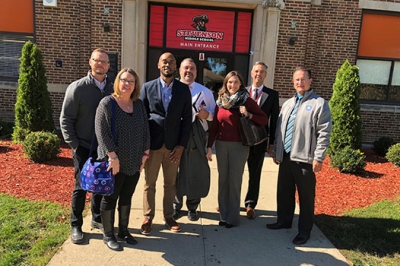On October 18, 2018 leaders from Stevenson Middle School in Melrose Park, Illinois hosted teachers and administrators from Metropolitan School District of Lawrence Township, located in Indianapolis, Indiana. It was a day of sharing between two schools in states affiliated with the Schools to Watch initiative and National Forum to Accelerate Middle-Grades Reform.
Lawrence is facilitating a comprehensive middle school review to analyze current programming and curriculum using the Schools to Watch Self-Study and Rating Rubric. Site visits to exemplary middle schools are part of the District’s review process. As they gathered at Stevenson Middle School, leaders discussed some of the similarities and differences between their buildings. Lawrence Junior High and Stevenson Middle School serve students from diverse socioeconomic and ethnic backgrounds and offer multi-tiered options for learners to best meet their academic needs. Similarly, both offer a standards-based approach to instruction with varied courses and electives.
 Though Lawrence and Stevenson share some commonalities, they differ in their operating models, teaming practices and scheduling structures. While Stevenson is a middle school serving 900 students in grades six through eight, Lawrence is a junior high serving 1,400 students in grades seven and eight. Stevenson has an integrated team structure offering daily common planning time for teachers, and Lawrence has a department structure without common planning time. The two schools’ schedules differ considerably as well; Lawrence maintains a 45-minute bell schedule, while Stevenson runs a block schedule.
Though Lawrence and Stevenson share some commonalities, they differ in their operating models, teaming practices and scheduling structures. While Stevenson is a middle school serving 900 students in grades six through eight, Lawrence is a junior high serving 1,400 students in grades seven and eight. Stevenson has an integrated team structure offering daily common planning time for teachers, and Lawrence has a department structure without common planning time. The two schools’ schedules differ considerably as well; Lawrence maintains a 45-minute bell schedule, while Stevenson runs a block schedule.
It was these many differences that illuminated for Lawrence leaders the profound effect an applied middle school philosophy can have in meeting the socioemotional and academic needs of students. Additionally, the group saw how the middle school model helps teachers and teams increase communication with families, positively impacting the culture and climate of the school.
“I think we gave the Lawrence group many things to think about: the change process, middle school structures,” said Stevenson Middle School Principal, James Parker. “Our staff learned more about ourselves. My staff is becoming more and more proud of what we do and more and more able to articulate what and why we do what we do.”
The productive exchange of ideas focused on the schools’ shared goal of offering the very best educational experience to learners in the middle grades. The Stevenson team shared how their middle school philosophy and approach has produced tangible outcomes for students and staff, and the Lawrence team saw firsthand how these structures and strategies may be enacted in their school.
“When successful schools with clear demographic and access-to-resource challenges can share with leaders from schools aspiring to better serve their children, reform is accelerated,” said Parker. “Rather than implementing unproven structures, leaders can create teams of educators who can connect with other educators who are not only surviving within middle school structures, but thriving within them. This validates what the aspirants believewill best serve their students, and renews their sense of purpose to make it happen in their home school.”
By hosting a school in the midst of a comprehensive review, Stevenson embraced their role as a School to Watch.The Association of Illinois Middle-grade Schools (AIMS) proudly partners with the National Forum to Accelerate Middle-Grades Reform to recognize schools that demonstrate academic excellence, developmental responsiveness, social equity and organizational structures and processes. Stevenson Middle School is one of the AIMS Network exemplary middle schools whose unique approach to addressing the many needs of a diverse student population has earned them state and national recognition.
